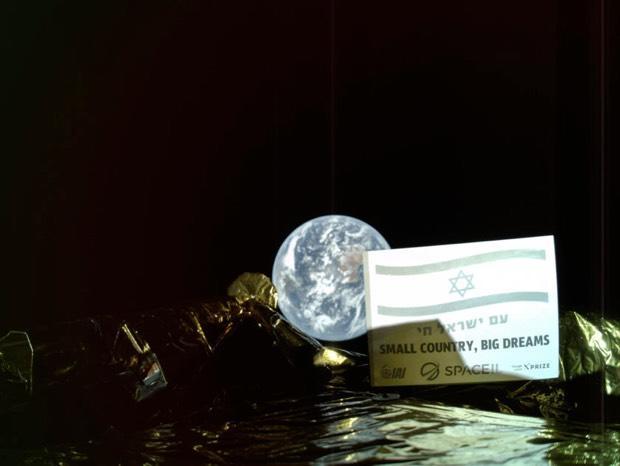Israeli lunar lander slips into orbit around the moon - CBS News
A small Israeli spacecraft executed a critical rocket firing Thursday, easing out of a highly elliptical Earth orbit and into one around the moon. It sets the stage for an automated landing attempt April 11.
The spacecraft is the first privately funded, non-superpower lunar lander.
"The lunar capture is an historic event in and of itself, but it also joins Israel in a seven-nation club that has entered the moon's orbit," said Morris Kahn, chairman of SpaceIL, the non-profit that brought the Beresheet moon landing mission to fruition. "A week from today we'll make more history by landing on the moon, joining three super powers who have done so. Today I am proud to be an Israeli."
Launched February 21 as a secondary payload aboard a SpaceX Falcon 9 rocket, the robotic Beresheet's main engine fired seven times over the past few weeks to raise the high point of its orbit to an altitude just past the moon's orbit 240,000 miles away.
 The Beresheet lunar lander captured this stunning view of Earth on its way to the moon. The small Israeli spacecraft will attempt a landing on the moon April 11.
SpaceIL
The Beresheet lunar lander captured this stunning view of Earth on its way to the moon. The small Israeli spacecraft will attempt a landing on the moon April 11.
SpaceIL
For Thursday's maneuver, a six-minute burn began at 10:18 a.m. ET, reducing Beresheet's velocity relative to the moon by about 620 miles per hour, just enough to allow lunar gravity to capture the spacecraft. The burn was designed to put the craft into an orbit with a low point of about 310 miles and a high point around 6,213 miles.
The firing was critical because without it, Beresheet would have sailed past the moon into a useless orbit around the sun, bringing the mission to a disappointing end.
But the rocket firing went smoothly, setting the stage for landing on a broad plain known as Mare Serenitatis on April 11. If successful, Israel will join the United States, Russia and China as only the fourth nation to land an operational spacecraft on the moon.
"After six weeks in space, we have succeeded in overcoming another critical stage by entering the moon's gravity," Ido Anteby, SpaceIL CEO, said in a statement. "We still have a long way until the lunar landing, but I'm convinced our team will ... land the first Israeli spacecraft on the moon, making us all proud."
Designed by SpaceIL and built by Israel Aerospace Industries for the since-cancelled Google Lunar X-prize competition, Beresheet is intended to spur interest in STEM careers among students across Israel and around the world. Funded largely by private donations, the spacecraft and launch costs totaled about $100 million, a bargain compared to past interplanetary missions.
But that relatively low cost came with added risk. The spacecraft has few redundant systems and its ability to recover from component failures or malfunctions is limited. Flight controllers already have had to work around problems with unexpected computer restarts and one of the spacecraft's star trackers.
Now that it's safely in orbit around the moon, however, the team's sights are set on landing. Over the next week, several maneuvers are planned to put Beresheet into a circular orbit at an altitude of about 124 miles. From there, the spacecraft will begin its descent.
 To reach the moon, the Beresheet lander hitched a ride on a SpaceX Falcon 9 rocket as a secondary payload.
SpaceIL
To reach the moon, the Beresheet lander hitched a ride on a SpaceX Falcon 9 rocket as a secondary payload.
SpaceIL
"The spacecraft will land autonomously," Anteby said earlier this week. "Actually, we'll send a command to land, and it will land by itself. We have never tested it, so we are not sure how it will work. We have done a lot of experiments and a lot of tests in the lab using a simulator, but we have never tested the spacecraft to land on the moon."
He said the moon landing could be thwarted by a single sensor failure.
"In order to begin the landing procedure, we need to give the spacecraft the exact location of where it is," he said. "This accurate positioning is very risky. We also have a special sensor, a laser sensor. This is the first time that this sensor will be on the moon, so it is very risky, too."
During the final descent, a magnetometer will measure the local magnetic field before the main engine shuts down at an altitude of about 16 feet. From there, the spacecraft will free fall to the surface.
Beresheet is equipped with a high-resolution camera to capture panoramic views of the landing site to help scientists better understand the area. The spacecraft also carries a small "time capsule" loaded with photos and cultural artifacts, including a copy of the Bible engraved on a coin-size disk.
"Until today, three superpowers have soft landed on the moon," said Yonatan Winetraub, co-founder of SpaceIL. "We thought it's about time for a change. We want to get little Israel all the way to the moon. This is the purpose of SpaceIL."